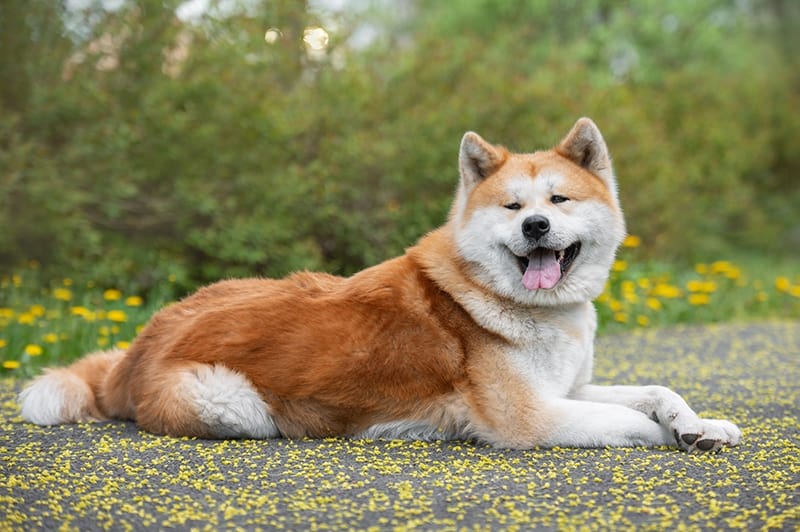
The handsome large Akita is a very intelligent, but strong-willed dog! ,
The Akita is also known as the Japanese Akita, Akita Inu, the Great Japanese Dog, and the nickname American Akita. It is a large muscular dog breed, bred to be a working dog. It can do well kept in small spaces as long as it also gets plenty of exercise time. They can become heavy if they are overfed and don’t get enough physical activity. Providing a yard and going for walks can help with exercise and activity.
Akitas are known for being loyal companions to their families. They make great guard dogs and are highly intelligent. But they need a patient and firm hand in training and socializing. Around children they are familiar with they do well, but must be carefully supervised with unfamiliar children. They also tend to be aggressive towards other types of pets. When selecting an Akita, check for signs of or predisposition to skin problems, hip dysplasia, and thyroid problems.
- Kingdom: Animalia
- Phylum: Chordata
- Class: Mammalia
- Order: Carnivora
- Family: Canidae
- Genus: Canis
- Species: lupus familiaris
Common Name(s)
Akita, American Akita, Akita Inu, Japanese Akita, Akita-Ken, Great Japanese Dog
Breed Type
The Akita is a working breed. Native to Japan, the Akita has been used as a guard dog, as a hunting dog, and in police and military work. It can be found in two styles, the American style allows for all coat colors The
Background
The Akita is an ancient breed descended from smaller Japanese hunting dogs, which were crossed with Tosas and Mastiffs in the 1800s to develop the breed as we know it. Reduced in number during World War II due to use as a source of fur, the Akita has since made a comeback thanks to breed devotees.
The Akita can be found in two styles.
- Akita
There is the American style which allows for all coat colors. It is officially called the Akita, however it is also referred to as the American Akita by one fancier club, the Federation Cynologique Internationale (FCI). - Akita Inu, Japanese Akita
The other is the Japanese style which accepts select colors only. It is called both Akita Inu and Japanese Akita.
Because of these two styles, there is a question among Akita fanciers whether there should be one recognized Akita breed or two. Clubs that consider this dog to be two types of the same breed include the American Kennel Club (AKC), the Canadian Kennel Club (CKC) and the Australian National Kennel Council (ANKC). Clubs from other nations, including Japan, consider there to be two separate breeds. These include The Kennel Club (KC), New Zealand Kennel Club (NZKC), and the Federation Cynologique Internationale (FCI).
Description
The Akita is a large dog with fluffy, thick fur. Accepted colors are red, fawn, sesame, and brindle with white markings on the chest, face, body and tail, or solid white. The head is blunt and triangular, the ears small and erect, and the eyes small and dark. Males are 26-28 inches in height and weigh 75-120 pounds. Females are 24-26 inches tall and weigh 75-110 pounds.
Care and Feeding
The Akita’s food should contain poultry, fish, rice and wheat. Some experts also recommend adding a mall amount of canned tuna to the Akita’s feedings. Care should be taken not to overfeed in order to prevent bloat. Regular brushing is crucial to keep your Akita’s coat looking its best. Baths should be given only when necessary in order to preserve the coat’s waterproofing.
Akitas need annual checkups to stay healthy. Vaccinations should be given as follows:
- 6-8 weeks: Distemper, Leptospirosis, Hepatitis, Parainfluenza, Parvo, and Corona virus (DHLPPC)
- 10-12 weeks: Second DHLPPC
- 14-16 weeks: Third DHLPPC and rabies
- Annually: DHLPPC and rabies booster
Akitas shed heavily at times, so regular vacuuming is crucial if they are to be kept indoors.
Housing Your Dog
The Akita is fairly active indoors, but can do well in small spaces as long as it gets plenty of exercise. A large yard is recommended.
Social Behaviors
Akitas are very loyal to their families. They usually do well with children they are familiar with, but should be carefully supervised with unfamiliar ones. They tend to be aggressive toward other pets of any type.
Handling and Training
Akitas are very intelligent, but they are also strong-willed and get bored easily. Trainers must be very patient and firm.
Activities
Akitas do not require a great deal of exercise, but they do need to go for a walk each day. They can also benefit from regular off-leash play sessions.
Breeding/Reproduction
When selecting a mate for your Akita, check bloodlines for skin problems (including autoimmune disorders that attack the skin), hip dysplasia, and thyroid problems.
Common Health Problems
Autoimmune disorders are particularly problematic in this breed, and they require veterinary treatment. Thyroid problems are also fairly common.
Availability
Akitas are reasonably easy to find in most areas. Prices are generally $700 and up, and may be in the thousands.
References
- Liz Palika, The Howell Book of Dogs: The Definitive Reference to 300 Breeds and Varieties , Howell Book House, 2007
- American Kennel Club, The Complete Dog Book: 20th Edition (Complete Dog Book) , Ballantine Books, 2006
- Kristin Mehus-Roe, The Original Dog Bible: The Definitive Source to All Things Dog, BowTie Press, 2005
- Akita (Dog), Wikipedia
- Akita (American Akita), Copyright Dog Breed Info Center
- Welton, Michelle, Akitas: What’s Good About ‘Em? What’s Bad About ‘Em?
- Akita Puppies for Sale, Copyright PuppyFind.com, LLC
Featured Image Credit: Kristina Chizhmar, Shutterstock
